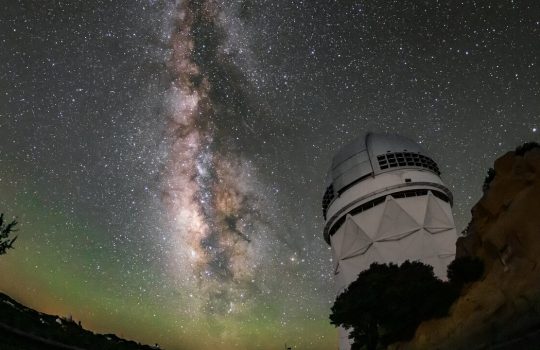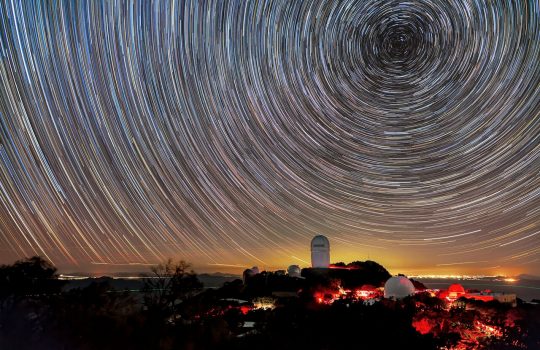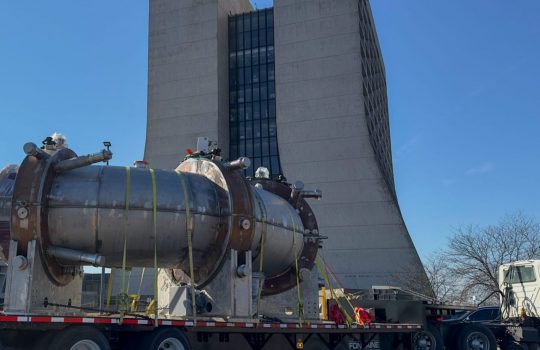The following press release on the Dark Energy Spectroscopic Instrument (DESI) was issued by the DESI collaboration. The U.S. Department of Energy’s Fermilab is a member of the collaboration, bringing expertise gained during the design, building and operation of the Dark Energy Camera to this next-generation instrument.
Fermilab scientists are managing key elements of the construction, including the heavy mechanical components (including the precise alignment of the structures that hold the lenses), the assembly of the charge-coupled devices, or CCDs, that capture light, and the online databases used for data acquisition. Fermilab is also providing software that maps between the locations of light sources in the sky and the positions of each of the 5,000 robotic fiber positioners that make up the DESI plane, drawing on more than 25 years of experience with the Sloan Digital Sky Survey and the Dark Energy Survey.
For more information on Fermilab’s role in DESI, please contact Andre Salles at media@fnal.gov or 630-840-3351.
Solving the dark energy mystery: a new assignment for a 45-year-old telescope
Kitt Peak National Observatory prepares for the Dark Energy Spectroscopic Instrument
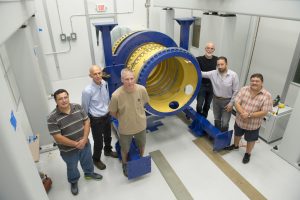
Members of the Fermilab team stand with the lens-holding barrel for the Dark Energy Spectroscopic Instrument. From left: Jorge Montes, Mike Roman, David Butler, Gaston Gutierrez, Giuseppe Gallo and Otto Alvarez. Photo: Reidar Hahn
Forty-five years ago this month, a telescope tucked inside a 14-story, 500-ton dome atop a mile-high peak in Arizona took in the night sky for the first time and recorded its observations in glass photographic plates.
Today, the dome closes on the previous science chapters of the 4-meter Nicholas U. Mayall Telescope so that it can prepare for its new role in creating the largest 3-D map of the universe. This map could help to solve the mystery of dark energy, which is driving the accelerating expansion of the universe.
The temporary closure sets in motion the largest overhaul in the telescope’s history and sets the stage for the installation of the Dark Energy Spectroscopic Instrument (DESI), which will begin a five-year observing run next year at the National Science Foundation’s Kitt Peak National Observatory (KPNO) —part of the National Optical Astronomy Observatory (NOAO).
“This day marks an enormous milestone for us,” said DESI Director Michael Levi of the Department of Energy’s Lawrence Berkeley National Laboratory (Berkeley Lab), which is leading the project’s international collaboration. “Now we remove the old equipment and start the yearlong process of putting the new stuff on.”
More than 465 researchers from about 71 institutions are participating in the DESI collaboration.
The entire top end of the telescope, which weighs as much as a school bus and houses the telescope’s secondary mirror and a large digital camera, will be removed and replaced with DESI instruments, noted KPNO Director Lori Allen. A large crane will lift the telescope’s top end through the observing slit in its dome.
David Sprayberry, KPNO site director for DESI, said, “The Mayall is being readied for an exciting second career probing the role of dark energy in the expansion history of the universe.”
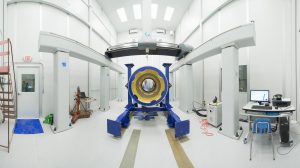
Fermilab built the lens-holding barrel of the Dark Energy Spectroscopic Instrument. Photo: Reidar Hahn
Besides providing new insights about the universe’s expansion and large-scale structure, DESI will also help to set limits on theories related to gravity and the formative stages of the universe and could even provide new mass measurements for a variety of elusive yet abundant subatomic particles called neutrinos.
“One of the primary ways that we learn about the unseen universe is by its subtle effects on the clustering of galaxies,” said DESI Collaboration Co-spokesperson Daniel Eisenstein of Harvard University. “The new maps from DESI will provide an exquisite new level of sensitivity in our study of cosmology.”
The Mayall Telescope has played an important role in many astrophysics discoveries, including measurements supporting the discovery of dark energy and establishing the role of dark matter in the universe from measurements of galaxy rotation. Its observations have also been used in determining the scale and structure of the universe. Dark matter and dark energy together are believed to make up about 95 percent of all of the universe’s mass and energy.
It was one of the world’s largest optical telescopes at the time it was built, and because of its sturdy construction it is perfectly suited to carry the new 9-ton instrument.
“We started this project by surveying large telescopes to find one that had a suitable mirror and wouldn’t collapse under the weight of such a massive instrument,” said Berkeley Lab’s David Schlegel, a DESI project scientist.
Arjun Dey, the NOAO project scientist for DESI, explained, “The Mayall was precociously engineered like a battleship and designed with a wide field of view.”
Allen added, “The redesign maintains the original intent of the facility as a wide-field telescope, but we are now taking that to its practical limit.”
The expansion of the telescope’s field-of-view will allow DESI to map out about one-third of the sky.
Brenna Flaugher, a DESI project scientist who leads the Astrophysics Department at Fermi National Accelerator Laboratory, said DESI will transform the speed of science at the Mayall Telescope.
“The telescope was designed to carry a person at the top who aimed and steered it, but with DESI it’s all automated,” she said. “Instead of one at a time, we can measure the velocities of 5,000 galaxies at a time — we will measure more than 30 million of them in our five-year survey.”
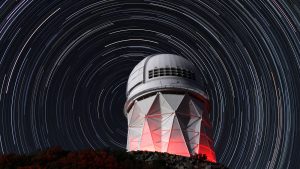
Kitt Peak National Observatory in Arizona will soon house the Dark Energy Spectroscopic Instrument. Photo courtesy of Lawrence Berkeley National Laboratory
DESI will use an array of 5,000 swiveling robots, each carefully choreographed to point a fiber-optic cable at a preprogrammed sequence of deep-space objects, including millions of galaxies and quasars, which are galaxies that harbor massive, actively feeding black holes.
The fiber-optic cables will carry the light from these objects to 10 spectrographs, which are tools that will measure the properties of this light and help to pinpoint the objects’ distance and the rate at which they are moving away from us. DESI’s observations will provide a deep look into the early universe, up to about 11 billion years ago.
The cylindrical, fiber-toting robots, which will be embedded in a rounded metal unit called a focal plane, will reposition to capture a new exposure of the sky roughly every 20 minutes. The focal plane is expected to be completed and delivered to Kitt Peak this year.
DESI will scan one-third of the sky and will capture about 10 times more data than a predecessor survey, the Baryon Oscillation Spectroscopic Survey (BOSS). That project relied on a manually rotated sequence of metal plates — with fibers plugged by hand into predrilled holes – to target objects.
All of DESI’s six lenses, each about a meter in diameter, are complete. They will be carefully stacked and aligned in a steel support structure and will ultimately ride with the focal plane atop the telescope.
Each of these lenses took shape from large blocks of glass. They have criss-crossed the globe to receive various treatments, including grinding, polishing and coatings. It took about three-and-a-half years to produce each of the lenses, which now reside at University College London in the UK, and will be shipped to the DESI site this spring.
The Mayall Telescope has most recently been enlisted in a DESI-supporting sky survey known as the Mayall z-Band Legacy Survey (MzLS), which is one of four sky surveys that DESI will use to preselect its targeted sky objects. That survey wrapped up just days before the Mayall’s temporary closure, while the others are ongoing.
Data from these surveys are analyzed at Berkeley Lab’s National Energy Research Scientific Computing Center (NERSC), a DOE Office of Science user facility. Data from these surveys have been released to the public at http://legacysurvey.org.
“We can see about a billion galaxies in the survey images, which is quite a bit of fun to explore,” Schlegel said. “The DESI instrument will precisely measure millions of those galaxies to see the effects of dark energy.”
Installation of DESI’s components is expected to begin soon and to wrap up in April 2019, with first science observations planned in September 2019.
“Installing DESI on the Mayall will put the telescope at the heart of the next decade of discoveries in cosmology,” said Risa Wechsler, DESI collaboration co-spokesperson and associate professor of physics and astrophysics at SLAC National Accelerator Laboratory and Stanford University. “The amazing 3-D map it will measure may solve some of the biggest outstanding questions in cosmology, or surprise us and bring up new ones.”
DESI is supported by the U.S. Department of Energy’s Office of Science; the U.S. National Science Foundation, Division of Astronomical Sciences under contract to the National Optical Astronomy Observatory; the Science and Technologies Facilities Council of the United Kingdom; the Gordon and Betty Moore Foundation; the Heising-Simons Foundation; the National Council of Science and Technology of Mexico; the Ministry of Economy of Spain; and DESI member institutions. The DESI scientists are honored to be permitted to conduct astronomical research on Iolkam Du’ag (Kitt Peak), a mountain with particular significance to the Tohono O’odham Nation.
Current DESI Member Institutions include: Aix-Marseille University; Argonne National Laboratory; Barcelona-Madrid Regional Participation Group; Brookhaven National Laboratory; Boston University; Carnegie Mellon University; CEA-IRFU, Saclay; China Participation Group; Cornell University; Durham University; École Polytechnique Fédérale de Lausanne; Eidgenössische Technische Hochschule, Zürich; Fermi National Accelerator Laboratory; Granada-Madrid-Tenerife Regional Participation Group; Harvard University; Korea Astronomy and Space Science Institute; Korea Institute for Advanced Study; Institute of Cosmological Sciences, University of Barcelona; Lawrence Berkeley National Laboratory; Laboratoire de Physique Nucléaire et de Hautes Energies; Mexico Regional Participation Group; National Optical Astronomy Observatory; Ohio University; Siena College; SLAC National Accelerator Laboratory; Southern Methodist University; Swinburne University; The Ohio State University; Universidad de los Andes; University of Arizona; University of California, Berkeley; University of California, Irvine; University of California, Santa Cruz; University College London; University of Michigan at Ann Arbor; University of Pennsylvania; University of Pittsburgh; University of Portsmouth; University of Queensland; University of Rochester; University of Toronto; University of Utah; University of Zurich; UK Regional Participation Group; Yale University. For more information, visit desi.lbl.gov.
Fermilab is America’s premier national laboratory for particle physics and accelerator research. A U.S. Department of Energy Office of Science laboratory, Fermilab is located near Chicago, Illinois, and operated under contract by the Fermi Research Alliance LLC, a joint partnership between the University of Chicago and the Universities Research Association Inc. Visit Fermilab’s website at www.fnal.gov and follow us on Twitter at @Fermilab.
Lawrence Berkeley National Laboratory addresses the world’s most urgent scientific challenges by advancing sustainable energy, protecting human health, creating new materials, and revealing the origin and fate of the universe. Founded in 1931, Berkeley Lab’s scientific expertise has been recognized with 13 Nobel prizes. The University of California manages Berkeley Lab for the U.S. Department of Energy’s Office of Science. For more, visit http://www.lbl.gov.
DOE’s Office of Science is the single largest supporter of basic research in the physical sciences in the United States, and is working to address some of the most pressing challenges of our time. For more information, please visit science.energy.gov.
The National Optical Astronomy Observatory (NOAO) is the national center for ground-based nighttime astronomy in the United States (www.noao.edu) and is operated by the Association of Universities for Research in Astronomy (AURA) under a cooperative agreement with the National Science Foundation Division of Astronomical Sciences.
The National Science Foundation (NSF) is an independent federal agency created by Congress in 1950 to promote the progress of science. NSF supports basic research and people to create knowledge that transforms the future.
Established in 2007 by Mark Heising and Elizabeth Simons, the Heising-Simons Foundation (www.heisingsimons.org) is dedicated to advancing sustainable solutions in the environment, supporting groundbreaking research in science, and enhancing the education of children.
The Gordon and Betty Moore Foundation, established in 2000, seeks to advance environmental conservation, patient care and scientific research. The Foundation’s Science Program aims to make a significant impact on the development of provocative, transformative scientific research, and increase knowledge in emerging fields. For more information, visit www.moore.org. The Science and Technology Facilities Council (STFC) of the United Kingdom coordinates research on some of the most significant challenges facing society, such as future energy needs, monitoring and understanding climate change, and global security. It offers grants and support in particle physics, astronomy and nuclear physics, visit http://www.stfc.ac.uk.

